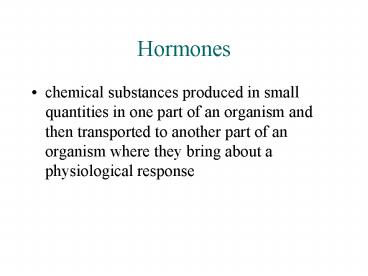Hormones - PowerPoint PPT Presentation
1 / 20
Title:
Hormones
Description:
usually produced in specialized tissue that serves only to produce hormones ... controls leaf, flower and fruit abscission and fruit ripening. 5. Abscisic acid ... – PowerPoint PPT presentation
Number of Views:39
Avg rating:3.0/5.0
Title: Hormones
1
Hormones
- chemical substances produced in small quantities
in one part of an organism and then transported
to another part of an organism where they bring
about a physiological response
2
Target Cells
- have receptors that allow them to recognize the
hormone and respond
3
Hormone Action
- Depends on
- Which hormone
- the effect on the target cells
4
Site of Hormone Production
- In animals
- usually produced in specialized tissue that
serves only to produce hormones
5
Site of Hormone Production
- In animals
- usually produced in specialized tissue that
serves only to produce hormones - In plants
- produced by tissue that is also used for some
other function (in the apical meristem, in seeds,
in fruits etc)
6
(No Transcript)
7
Plant Hormones
- Five major types
- 1. Auxins
- promotes growth and cell division
- 2. Cytokinins
- promotes cell division
- 3. Gibberellins
- promotes stem elongation, seed germination
- 4. Ethylene
- controls leaf, flower and fruit abscission and
fruit ripening - 5. Abscisic acid
- promotes leaf senescence, controls stomatal
closure and seed dormancy
8
Plant Hormones
- Five major types
- Typically work together to control various
aspects of plant growth, reproduction and
development - Auxins
- promotes growth, stem elongation, cell division
- Promotes lateral bud dormancy
- Cytokinins
- promotes cell division (with auxin)
- Promotes bud formation (lateral buds when auxin
not present)
9
Figure 39.8 Apical dominance with apical bud
(left), apical bud removed (right)
10
Plant Hormones
- Five major types
- 3. Gibberellins
- promotes stem elongation
- Speed seed germination
11
Auxin
- -increases the plasticity of cell walls and
promotes elongation of stems - -involved in the response of plants to light
(phototropisms)
12
(No Transcript)
13
Hormones in Animals
- secreted by
- specialized nerve cells called neurosecretory
cells - neurons that receive signals from other neurons
and respond by releasing hormones - specialized cells called endocrine cells
- usually organized into an endocrine gland
14
Glands
- Secretory organs
- Endocrine glands
- Produce hormones and secrete them into body
fluids - Are ductless
- Exocrine glands
- Produce variety of substance
- Convey them directly to the target via ducts
15
(No Transcript)
16
Vertebrate Hormone Example
- Islets of Langerhans in the Pancreas
- Control of blood glucose levels
- Alpha cells produce glucagon (raises blood
glucose level) - Beta cells produce insulin (takes glucose out of
the blood) - Insulin and glucagon are antagonistic hormones
17
(No Transcript)
18
Interaction of Nervous System and Endocrine System
- often cooperate and interact to maintain
homeostasis of the individual - some endocrine glands are controlled by the
nervous system - Hypothalamus
- pituitary gland (master gland)
- Many tropic hormones that stimulate growth in
their target organs
19
(No Transcript)
20
Nervous EndocrineSystem System
- More structurally complex less complex
- Network of neurons branching organized into
glands - throughout the body
- Neurons conduct electrical signals hormones
released into - directly to the target the blood and travel
- throughout the body but only
affect target - Very fast conduction of signal may take minutes
to hours to days for response
to occur































